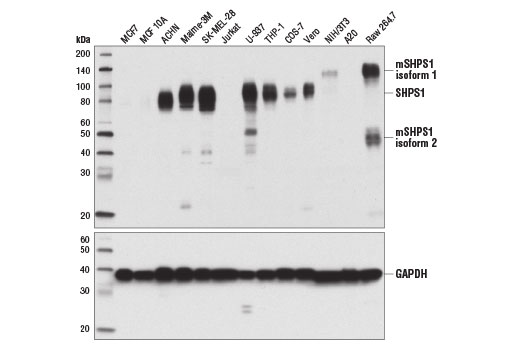

品牌: CST
 下载产品说明书
下载产品说明书 下载SDS
下载SDS 用小程序,查商品更便捷
用小程序,查商品更便捷



 收藏
收藏
 对比
对比 咨询
咨询分子量:
85 (human, monkey), 100 (rat), 120 (murine isoform 1), 55 (murine isoform 2)
85 (human, monkey), 100 (rat), 120 (murine isoform 1), 55 (murine isoform 2)
产品介绍
产品信息
分子量
85 (human, monkey), 100 (rat), 120 (murine isoform 1), 55 (murine isoform 2)

背景
背景
SHP-substrate 1 (SHPS1, SIRPα) is a single-pass membrane protein and member of both the immunoglobulin superfamily and the signal regulatory protein (SIRP) family. Following growth hormone stimulation or integrin binding, SHPS1 is phosphorylated at several tyrosine residues within its cytoplasmic tail. These phosphorylation events promote association between SHPS1 and multiple signaling proteins, including SHP-1, SHP-2, Grb2 and Shc via their SH2 domains (1-4). Recruitment of SHP-1 and SHP-2 results in SHPS1 dephosphorylation and suppression of tyrosine kinase signaling (1-3,5). The tyrosine kinase JAK2 associates with SHPS1 via its carboxy terminus and phosphorylates SHPS1 in response to extracellular stimuli (5). Research studies show that Src associates with and may phosphorylate SHPS1 in response to insulin (4). In macrophages, SHPS1 can form a complex with the Src pathway adaptor protein SKAP2, Fyn-binding protein FYB, and the tyrosine kinase PYK2 (6). The SHPS1 extracellular domain contains at least three IgG-like domains that interact with CD47, a ubiquitously expressed, integrin-associated protein that acts as a repressive cue in both immune and neuronal cells (7,8). The interaction between CD47 and SHPS1 on opposing cells can inhibit cellular migration (9), promote "tethering" between macrophages and target cells during engulfment (10), facilitate self versus non-self recognition (11), and maintain immune homeostasis (12). SHPS1 plays a critical role in modulating the immune response and inflammation, and may play a role in neuronal development (13,14). The interaction between SHPS1 and CD47 may be an exploitable target in cancer therapy (15-17).
1.Kharitonenkov, A. et al. (1997) Nature 386, 181-6.
2.Ochi, F. et al. (1997) Biochem Biophys Res Commun 239, 483-7.
3.Takada, T. et al. (1998) J Biol Chem 273, 9234-42.
4.Shen, X. et al. (2009) Mol Cell Proteomics 8, 1539-51.
5.Stofega, M.R. et al. (2000) J Biol Chem 275, 28222-9.
6.Timms, J.F. et al. (1999) Curr Biol 9, 927-30.
7.Seiffert, M. et al. (1999) Blood 94, 3633-43.
8.Vernon-Wilson, E.F. et al. (2000) Eur J Immunol 30, 2130-7.
9.Motegi, S. et al. (2003) EMBO J 22, 2634-44.
10.Tada, K. et al. (2003) J Immunol 171, 5718-26.
11.van Beek, E.M. et al. (2005) J Immunol 175, 7781-7.
12.Legrand, N. et al. (2011) Proc Natl Acad Sci U S A 108, 13224-9.
13.Sarfati, M. et al. (2008) Curr Drug Targets 9, 842-50.
14.Matozaki, T. et al. (2009) Trends Cell Biol 19, 72-80.
15.Hara, K. et al. (2011) Cancer Res 71, 1229-34.
16.Willingham, S.B. et al. (2012) Proc Natl Acad Sci U S A 109, 6662-7.
17.Weiskopf, K. et al. (2013) Science 341, 88-91.

研究领域
癌症,纤维化,免疫学和肿瘤学,神经科学,
声明 :本官网所有报价均为常温或者蓝冰运输价格,如有产品需要干冰运输,需另外加收干冰运输费。







 危险品化学品经营许可证(不带存储) 许可证编号:沪(杨)应急管危经许[2022]202944(QY)
危险品化学品经营许可证(不带存储) 许可证编号:沪(杨)应急管危经许[2022]202944(QY)  营业执照(三证合一)
营业执照(三证合一)